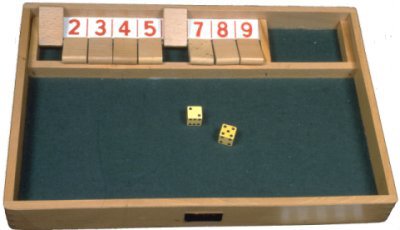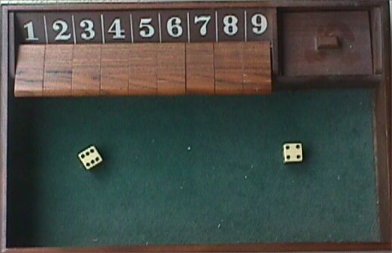
The photo at the left is the game of "Shut-the- Box" manufactured by Brio in Sweden. It has the Brio serial number of 18360.
This tablegame was purchased by the Museum in 1972. It is thought that game was devised by Normandy sailors in the 18th century. Many variations of this game are found in clubs, taverns, and in homes throughout the world, but generally they look like the Brio version.
The hardwood "box" is 26.2cm long x 38.6cm wide x 4.3cm high. The interior floor of the box is lined with green felt. The box is divided into 3 sections by narrow strips of wood. The front section is 27cm long x 36.9cm wide, and is the playing surface into which dice are thrown. The back has 2 sections. The right section is 9.8cm wide x 6.3cm deep, used to store dice, or to hold the player's bets. The left section is 25.2cm wide x 6.3cm deep. Along the back is sloping strip of wood 2.6cm long painted white, divided into 9 squares by red lines. Each square contains a number from 1 to 9 painted in red. In front of the numbers are 9 blocks of wood flanges, 4cm long x 2.7cm wide x .8cm high, threaded on a steel rod. Each flange can be individually flipped up to cover the number behind, or flipped down to expose the number. The vertical side at front has a black rectangular sticker, 1.8cm long x 3.8cm wide, giving the game name, place of manufacture in gold print. The bottom side of the box has an attached rectangular paper, 22cm long x 13cm wide, containing instructions printed in black.. The pair of plastic dice on the playing surface are standard dice with one to six pips.

A somewhat more expensive version of the same game is pictured on the right. This set was purchased in New York City in the 1960s from a men's furnishing shop.
The design and dimensions are similar to the Brio set, except that the box is made of solid mahogany and is somewhat larger. The dice are also oversized, and the storage compartment at the back has a cover. The numbers across the back are painted on to a washable fabric which is attached to the back.
As indicated, there are a number of versions of this game, and here is one way to play.
Two to six people may play. Players decide if they are playing for score only or a cash prize. If the game is for a cash prize, each player places an agreed upon sum in the back covered section of the box.
The box is placed on a table in front of the first player. All the numbers are uncovered at this time. The first player picks up the dice and throws them into the front section of the box. Using the faces of the dice which are on top, the player decides upon a combination of corresponding open numbers in the box that equal the total exposed. For example, in the photograph above one dice face is 6 and the other is 4 - making a total of ten. The player using the flanges at the rear of the box can close either the "9 & 1", or "8 & 2", or "7 & 3", or "7 & 2 & 1" or "6 & 4", or "6 & 3 & 1" or "5 & 3 & 2". However, the player can choose only one of these combinations, and after making a choice, closes the appropriate flanges. Let's assume the player has chosen to "close" the "6 & 4". Then the player picks up the dice and throws them again into the front section of the box.
This time the dice land with 3 and 3 showing. Since the player has already closed the "6 & 4", choices are now limited to "5 & 1" or "3 & 2 & 1" in order to make a total of "6". The player chooses "5 & 1" and closes the flanges for these numbers, and throws the dice again. This next time the dice show a 5 and a 4. Since the "4", "5", "6", and "1" are closed, the player must choose either the "9" or "7 & 2" as the only open alternatives. The "9" is chosen. The player then throws the dice a fourth time and 4 and 2 show. There are no open numbers that can make a total of 6, so the player's turn is over.
The player's score is calculated by adding together the opened numbers - in this example "8+7+3+2=20". The box is passed to the next player who tries to finish with a lower score than the first player. The game continues in this manner. The winner of the round is the player with the lowest score!
Last update March 25, 2010